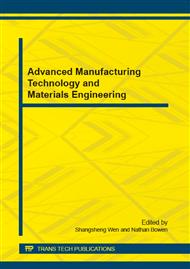p.308
p.312
p.318
p.323
p.327
p.331
p.335
p.339
p.343
Adaptive Inverse Fuzzy Decoupling Control of Bearingless Asynchronous Motor
Abstract:
The traditional control has good performance in the control of linear systems while has poor performance in the control of nonlinear systems. The bearingless asynchronous motor is a multivariable nonlinear system with high coupling. In this paper, the method of adaptive inverse control is proposed for these reasons. Firstly, the mathematical model of the bearingless asynchronous motor is built, and the possibility of the existence of the bearingless asynchronous motor system inverse model is explored. Secondly, since the object to be controlled is highly nonlinear and has high variability. In this paper, adaptive inverse fuzzy decoupling control is used to make up the deficiency of traditional adaptive inverse control. Finally, the Matlab simulation model is established. The simulation results show that the control method has good dynamic and static performance.
Info:
Periodical:
Pages:
327-330
Citation:
Online since:
December 2014
Authors:
Price:
Сopyright:
© 2015 Trans Tech Publications Ltd. All Rights Reserved
Share:
Citation:


